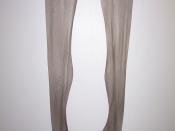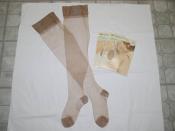In 1931, American chemist Wallace Carothers carried out research for the DuPont Company on giant molecules called polymers. He concentrated his work on a particle polymer he called simply "66", a number derived from its molecular structure, this molecule was later renamed nylon.
Nylon created a revolution in the fibre industry. Nylon's forerunners, rayon and acetate had been made from plant cellulose but nylon was synthesised completely from petrochemicals.
DuPont began commercial production of nylon in 1939, using nylon first as a sewing thread, in parachute fabric and in women's hosiery. Nylon stockings were showcased in the 1939 San Francisco Exposition. However, American women's introduction to the nylon hose was short lived. The United States entered World War II in December 1941 and the War Production Board allocated all nylon for military use. Nylon hose, which sold for $1.25 a pair before the War, sold for $10 a pair on the black market during the war.
Wartime stars like Betty Grable auctioned nylon hose for as much as $40 000 a pair to raise money for the war effort.
During the war, nylon replaced silk in parachutes, it was also used in tires, tents, ropes, ponchos and other military equipment. It was also used in the manufacture of US currency.
After the war, the conversion of nylon production to civilian uses began and when the first small quantities of nylon stockings were advertised, thousands of frantic women lined up at New York department stores to buy them. Immediately after the war, most nylon production went towards satisfying the demand for hosiery, but by the end of the 1940s, it was also being used in carpets and car upholstery.
By the 1950s, further well-known artificial fibres were being developed and manufactured such as acrylic, polyester and spandex.





